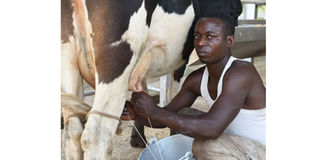How to keep milk clean and marketable

Precautionary measures such as tying the hind legs is a must before milking a cow. File photo
What you need to know:
The milking parlour should be frequently cleaned to remove slurry. Milking and milk storage containers must be made of food-grade materials, preferably aluminium cans, writes Lominda Afedraru.
Quality milk is essential for production of dairy products, taste and flavour, free from pathogens and will last longer without going bad.
A dairy farmer aiming to gain good proceeds for milk production is therefore expected to follow good management practices.
The same applies to processors who will finally deliver the product to consumers. In order for milk to reach the processor and ultimately the consumer in good condition, a number of things must be observed right from farm level to the processing factory, and thereafter to the retailers and consumer.
Dr Halid Kirunda, director of Mbarara Zonal Agriculture Research Development Institute (MbaZARDI) takes Seeds of Gold through the best practices.
Hygiene on the farm
Dr Kirunda explains that clean milk production begins with the health of the animal. This means the cow should be kept free from diseases which may end up being transmitted to the milk.
The udder of the cow must be cleaned thoroughly before milking is done. As milking starts, the milkman is expected to control flies from dropping into the milk container.
Whether milking by hand or machine, good hygiene is essential and this requires the person milking to have their hands and clothes clean.
The milking machine and milk storage equipment such as milk churns are kept clean and are in good condition. They should not be cracked otherwise it may cause difficulties in cleaning and this can easily harbour bacteria. Immediately after milking, the milk must be cooled preferably to 4° C. This will keep it sterile causing no growth of microorganisms. This requires mechanical refrigeration or milk cooling tanks. These are expensive and can usually only large scale commercial farmers can afford them.
For small scale dairy farmers, setting up a milk cooling centre centrally may be the ideal solution.
Where farmers bring their milk to a cooling centre through a co-operative, they should do so as soon as milking is completed.
A milk cooling centre with a capacity of 1000 - 3000 litres will serve up to 300 small holder farmers ensuring that the quality of their milk when produced under hygienic conditions is well preserved and accepted at the processing plant. It is important to remember that under a hot environment milk will spoil within 3-4 hours. So any means of cooling that will lower the temperature of milk from 38° C and this will help to prevent multiplication of bacteria.
Farmers are expected to ensure the milk is free from debris and sediment, has the right flavour, normal composition and acidity and free of antibiotics and chemical residues.
How to handle the cows
Milk from cows treated with antibiotics should not be mixed with milk from healthy cows.
Dairy farmers must observe the required four-day withdrawal period. Milk with antibiotics will affect consumers’ health as well as spoiling activity of lactic starter cultures used in cheese, yoghurt and Mala manufacture.
Transporting milk to processing factory
Milk cooled on the farm or cooling centre may be transported in milk cans or in bulk tankers. Bulk tankers are insulated, so the milk will remain cold until it reaches the plant provided the transport is fast.
It is important to consider good roads which will enable milk to be delivered before the temperature of milk rises above.
Transporting in cans
Alternatively, such milk may be filled in cans and transported in milk cans. This has the advantage that a farmer having poor quality milk will not mix it with other farmers having good quality milk.
Since the cans are not insulated, the transport to the factory must be efficient enough to enable milk reach the factory in acceptable condition.
In the case of farmers delivering milk via pick-up collection points it is advisable that the milk cans are placed in a shaded area while awaiting pick-up by a milk transport vehicle.
Milking machines
Milking machines should be cleaned according to recommended practice which include use of hot water and detergents.
Farmers must ensure timely replacement of worn out rubber parts.
General hygiene guidelines in factories
Floors of dairy buildings must be made of bard washable surface. Walls should be smooth and washable to about two metres from floor level and painted with light colour.
Doors should be self-shutting while windows should be rendered insect proof by mosquito netting to keep flies out. Rooms should be kept clean and in good repair.
All product-contact surfaces should be kept cleaned immediately before use or as often as necessary, by cleaning techniques appropriate to the equipment and process.
Equipment and utensils should be disinfected immediately before use and whenever there has been possibility of accidental contamination.
Equipment repairs and maintenance should preferably be carried out after processing.
Whenever machines have to be fixed during production runs, adequate precautions should be taken to prevent contamination of dairy products.
Equipment used for handling liquid milk products should preferably be cleaned and disinfected after each period of use and at least daily. This will enhance a better product on market.




